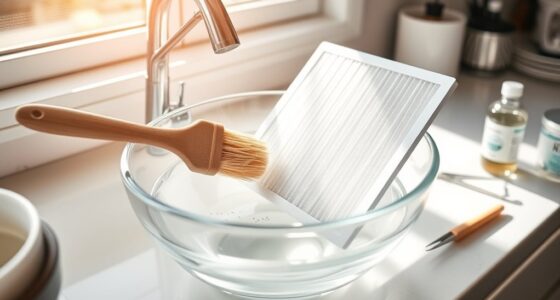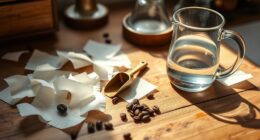Many people make the mistake of using a one-size-fits-all grind setting without adjusting for brewing method or bean roast level. You might rely only on grind charts without tasting, or forget to take into account water temperature and pressure. Ignoring bean freshness, confusing grind labels, or assuming all grind sizes are equal can ruin your brew. To get the best results, learn to fine-tune your grind based on these factors—keep exploring for more tips.
Key Takeaways
- Relying solely on grind size charts without tasting can lead to improper extraction and flavor issues.
- Using a fixed grind setting for all brewing methods ignores the need for method-specific adjustments.
- Ignoring water temperature, pressure, and environmental cues like grind noise can cause inconsistent results.
- Not considering bean roast level and freshness when selecting grind size results in over- or under-extraction.
- Failing to regularly calibrate and taste after brewing prevents fine-tuning for optimal flavor and consistency.
Using a One-Size-Fits-All Grind Setting
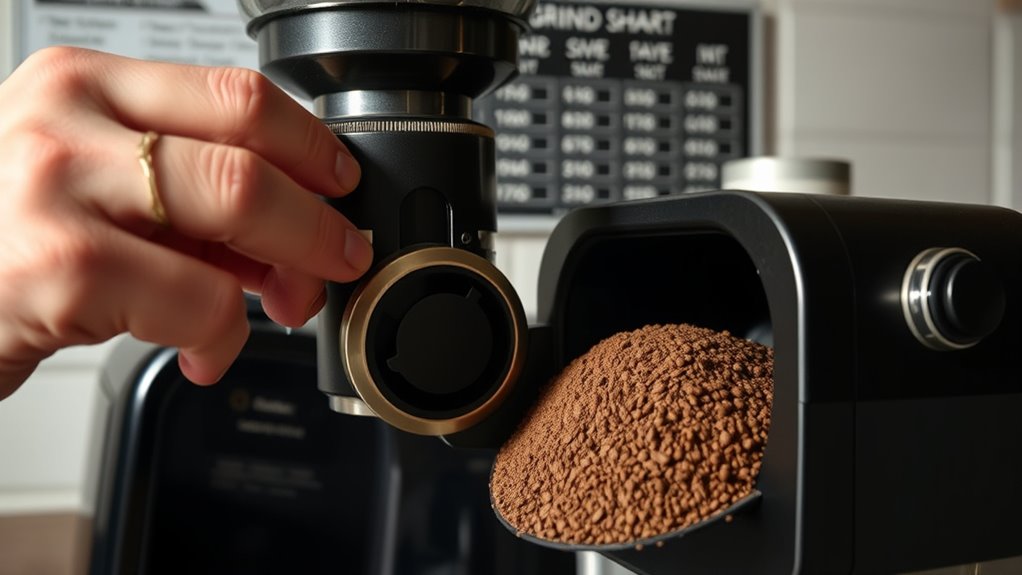
Many people assume that one grind setting works for all brewing methods, but this simply isn’t true. Your grind size aesthetics impact how your coffee extracts and the flavor profile you get. Using a one-size-fits-all setting can lead to over-extraction or under-extraction, making your coffee taste dull or bitter. It’s essential to adjust your grind based on your brewing method, whether it’s espresso or French press. Additionally, maintaining your grinder regularly ensures consistent results and preserves the quality of your grind. Proper grinder maintenance prevents clogs and uneven particle sizes, helping you achieve the perfect grind every time. Don’t rely on a single setting—fine-tune your grind to match the method and keep your coffee tasting its best. Understanding grind size and its impact on extraction is key to mastering your brewing technique.
Ignoring the Coffee Bean Roast Level
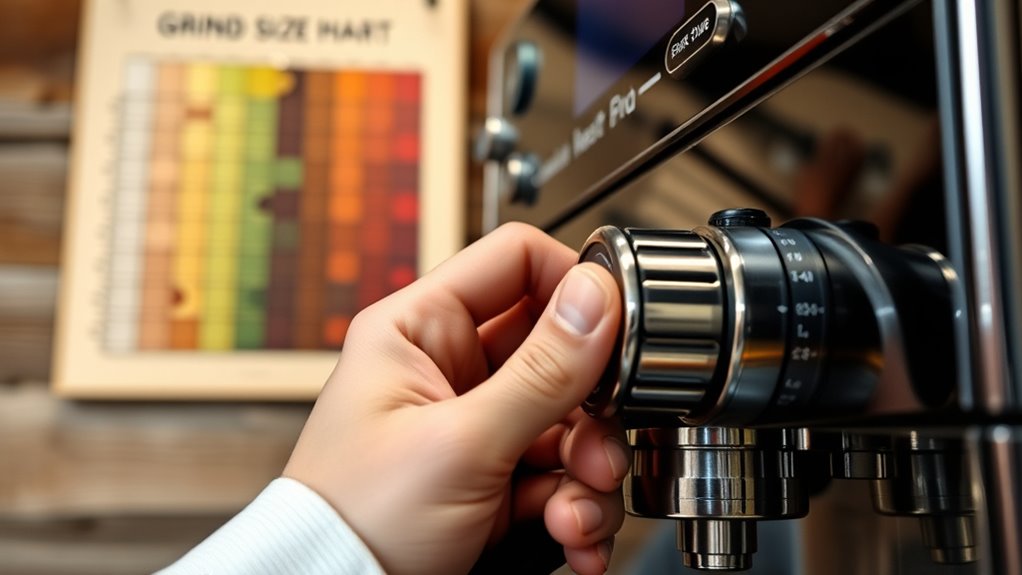
Ignoring the coffee bean roast level can considerably affect your grind size choice and, ultimately, the flavor of your brew. Light roasts are denser and require a slightly coarser grind to allow proper extraction, while dark roasts are softer and often need a finer grind for ideal flavor. If you don’t adjust your grind size based on roast level, you risk over- or under-extraction, which can lead to bitter or weak-tasting coffee. Additionally, the roast level influences brew temperature—darker roasts often need slightly lower temperatures to prevent over-extraction. Pay attention to grind consistency, too; uneven grind sizes can cause inconsistent extraction regardless of roast. By considering roast level, you help guarantee your grind size and brew temperature work together to produce a balanced, flavorful cup. Properly matching grind size to roast level can also improve the overall extraction process and enhance your brewing results.
Not Adjusting Grind Size for Different Brewing Methods
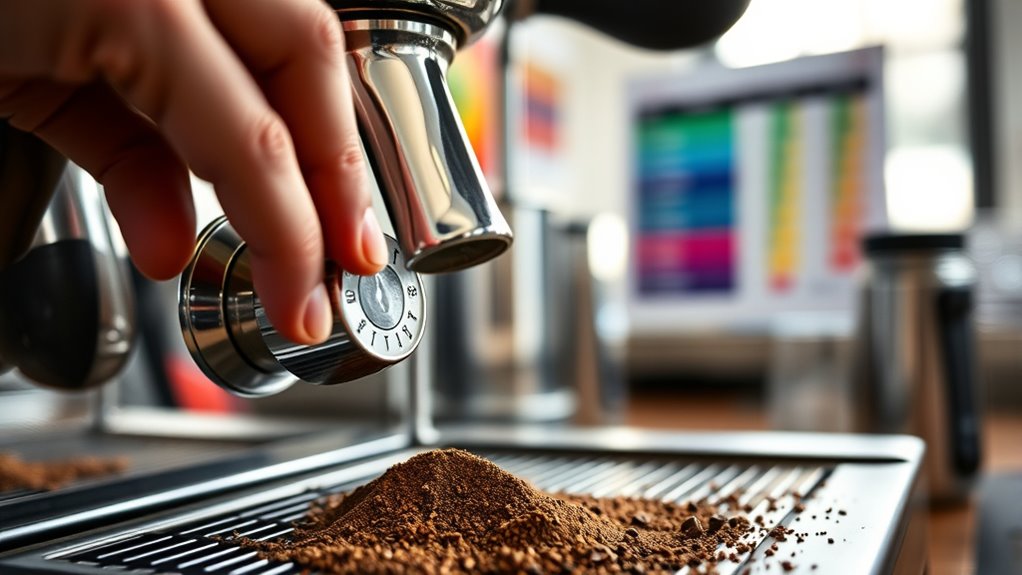
Adjusting your grind size to match different brewing methods is key to extracting the best flavor from your coffee. A finer grind works well for espresso, while a coarser grind suits French press or cold brew. Neglecting this can lead to under- or over-extraction, affecting taste. Remember, grind size influences bloom time and brewing temperature; a finer grind may require shorter bloom times to prevent over-extraction, whereas a coarser grind may need longer contact for proper extraction. Incorporating proper grind size into your routine ensures a balanced and flavorful brew.
Adjust grind size to optimize flavor; finer for quick brews, coarser for slow extraction.
- Match grind size to brewing method for ideal extraction
- Adjust bloom time based on grind fineness
- Modify brewing temperature to compensate for grind size differences
- Use a finer grind for quick brews, coarser for slow extraction
- Experiment to find the perfect balance for each method
Relying Solely on the Grind Chart Without Tasting
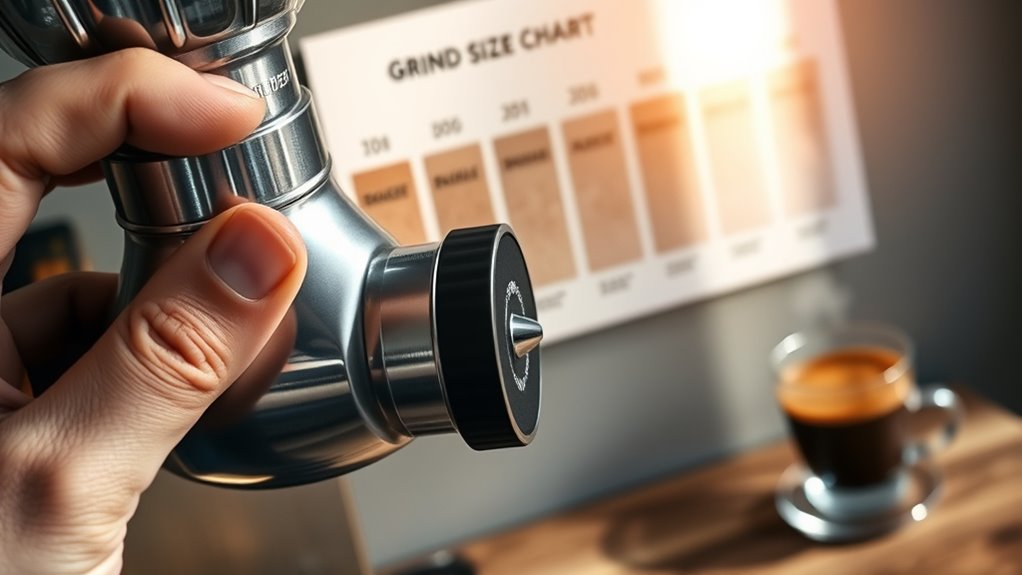
While using a grind chart as your primary guide can be helpful, relying on it exclusively often leads to subpar coffee. Grind size is just one piece of the puzzle; without taste testing, you miss critical insights into flavor profiling. Every bean and roast responds differently, so your palate is the best tool for adjustments. After brewing, take a sip and note the flavors—are they overly bitter, sour, or flat? Use these impressions to tweak your grind size rather than sticking rigidly to the chart. This iterative process ensures you’re tailoring your grind to your specific beans and taste preferences. Remember, a perfect cup comes from both following guidelines and actively tasting to refine your approach.
Overlooking the Impact of Freshness on Grind Consistency
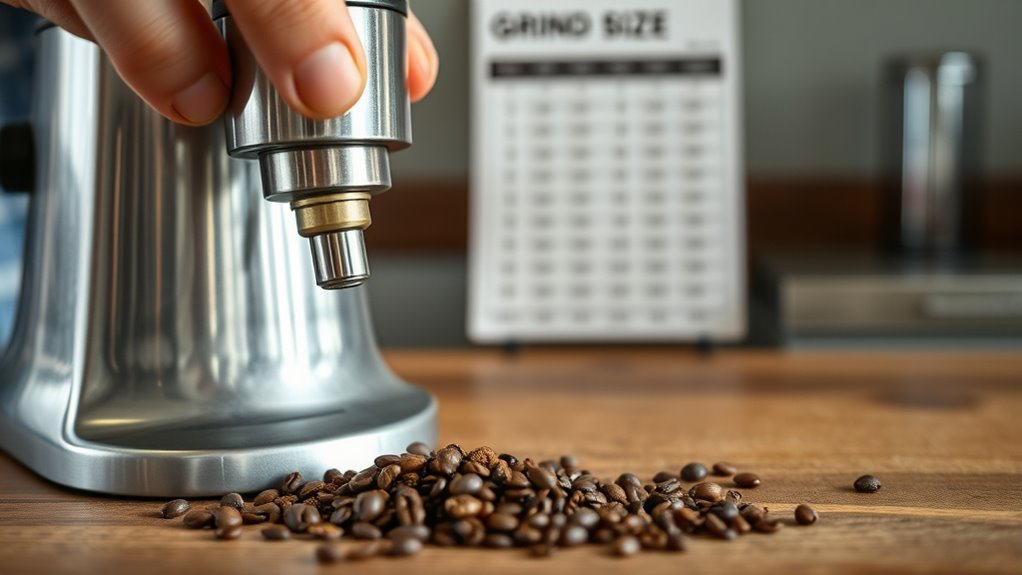
You might not realize that fresh beans produce more consistent grinds, while stale beans can lead to irregular grounds. When beans lose their freshness, their structure changes, making it harder to achieve uniformity. Ignoring this can compromise your grind quality and, ultimately, your brew. Using the right headphone jack types can also improve your listening experience.
Freshness and Grind Uniformity
Freshness plays a crucial role in achieving consistent grind size, yet many overlook its impact on grind uniformity. When beans are fresh, their oils and structure help produce a more even grind. Stale beans, on the other hand, tend to break unevenly, compromising flavor preservation and aroma consistency. To optimize your grind:
- Use freshly roasted beans within a week of roasting
- Store beans in an airtight container away from light and heat
- Avoid grinding beans that are too old or exposed to moisture
- Regularly calibrate your grinder for consistent particle size
- Recognize that fresher beans generally produce more uniform grounds, enhancing flavor and aroma. Color consistency is also affected by freshness, since oils and bean integrity influence how evenly the grounds are produced.
Stale Beans, Irregular Grounds
When beans become stale, their ability to produce a consistent grind diminishes markedly. Stale beans tend to produce irregular grounds because their oils and moisture have evaporated or oxidized, affecting how they break apart. This inconsistency can lead to uneven extraction, resulting in weak or bitter coffee. Using stale beans also makes it harder to dial in your grind size accurately, as the grind may appear consistent but doesn’t yield the desired flavor. To fix this, always use fresh beans within a few weeks of roasting. Store them in airtight containers away from light and heat. Regularly replacing your beans ensures your grinder produces uniform grounds, giving you better control over brew strength and flavor consistency. Fresh beans are key to achieving even, reliable grounds every time.
Forgetting to Calibrate Your Grinder Regularly
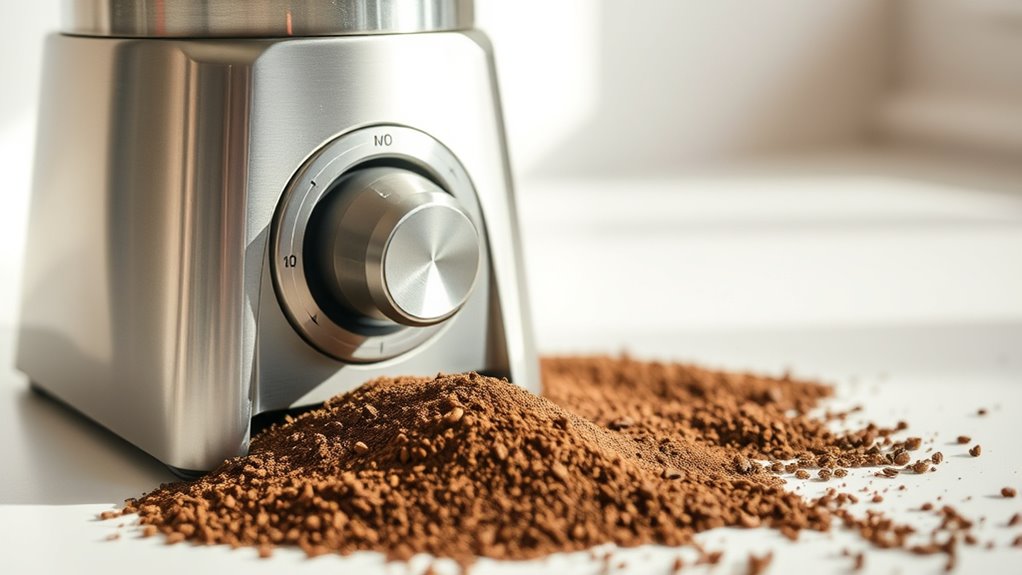
Regularly calibrating your grinder is essential to maintaining consistent brew quality, yet it’s often overlooked. Without proper grinder maintenance, your grind size can become uneven, affecting extraction and flavor. Establishing a calibration schedule helps ensure your grinder stays accurate over time. Neglecting this step leads to inconsistent results and wasted beans. To stay on top of calibration, consider these tips:
- Check grinder settings before each brewing session
- Record adjustments after calibration for future reference
- Clean burrs regularly to prevent build-up
- Use a calibration tool to verify grind size accuracy
- Adjust for changes in bean roast or origin
- Being aware of cultural influences can help understand how regional practices may affect your grinding routine.
Incorporating these practices into your routine guarantees a more reliable grind size, optimizing flavor and consistency with every brew.
Assuming All Grind Sizes Are Equally Fine or Coarse
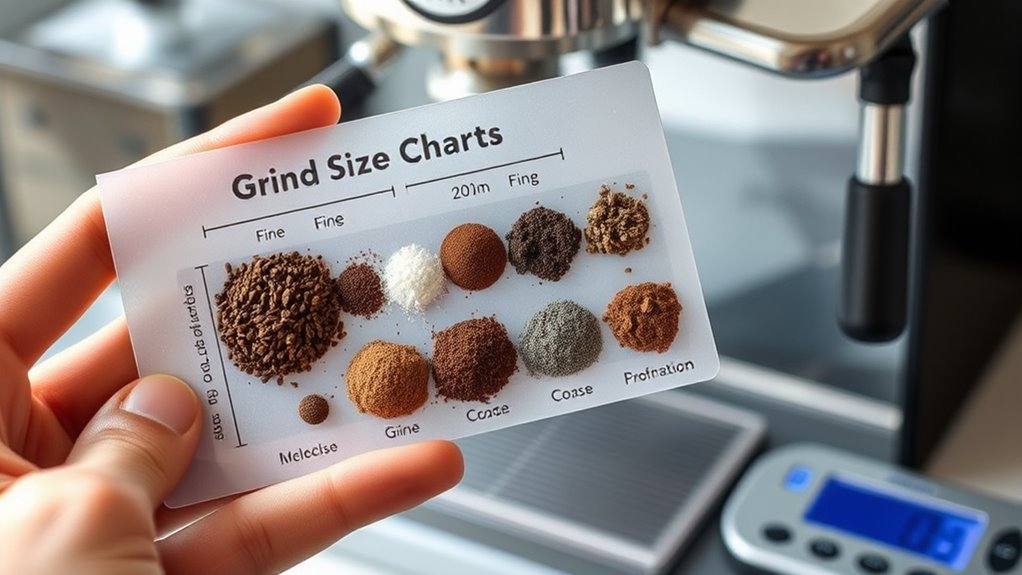
Many people assume that all grind sizes fall into just two categories—fine or coarse—but in reality, there’s a wide spectrum of grind sizes that serve different brewing methods. Each grind size impacts brew strength and flavor, so choosing the wrong one can lead to weak or overly bitter coffee. For example, a slightly finer grind produces a stronger brew, while a coarser grind results in a lighter taste. Additionally, grind noise varies with size; finer grinds tend to be noisier during grinding, which can be a clue if you’re unsure. Assuming all grind sizes are equally fine or coarse oversimplifies the process and hampers your brewing quality. Understanding the nuances helps you optimize brew strength and enjoy a more consistent cup. Recognizing the specific grind size that matches your brewing device, such as a Best Modern Toilet, can ensure optimal performance and results.
Neglecting to Consider Water Temperature and Pressure
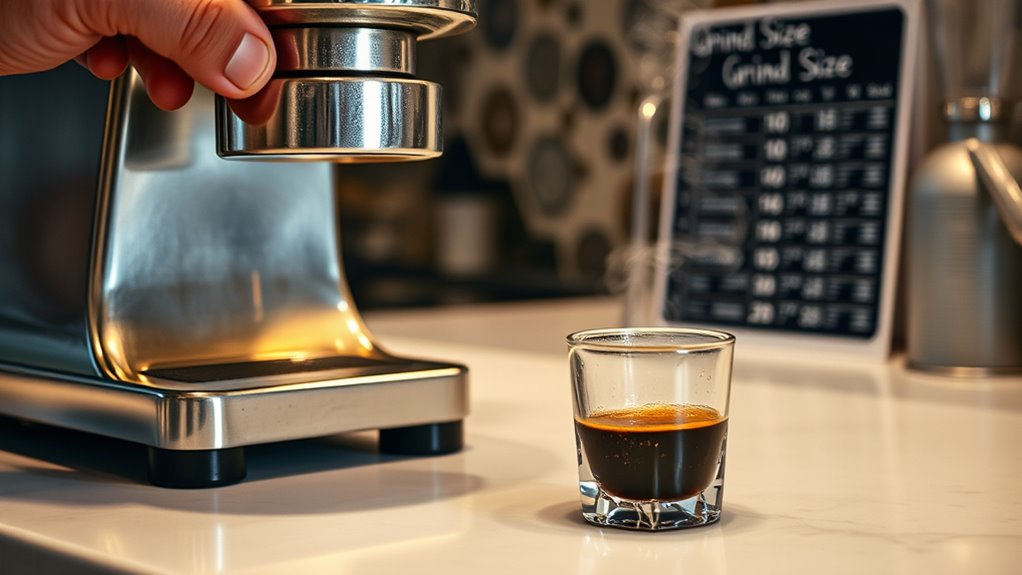
Water temperature and pressure play a vital role in extracting the best flavors from your coffee. If you overlook these factors, even the perfect grind size can lead to under- or over-extraction. Adjusting for pressure helps guarantee consistent, balanced results every time you brew. Incorporating precise water temperature control can further optimize extraction and enhance overall taste.
Water Impact on Extraction
Ignoring water temperature and pressure can markedly hinder your extraction process, even if your grind size is perfect. Water chemistry and temperature directly influence how flavors dissolve from your coffee grounds. If water isn’t at the right temperature, extraction may be underdeveloped or over-extracted, leading to weak or bitter brews. Incorporating data privacy concerns into your process can also impact how your brewing equipment handles sensitive information, ensuring both quality and security. Consider these factors:
- Water chemistry, including mineral content, affects solubility and flavor clarity.
- Proper water temperature ensures ideal extraction without scorching or under-extracting the coffee.
- Inconsistent pressure can cause uneven extraction, impacting taste.
- Hard water can lead to scale buildup, affecting water flow.
- Adjusting water temperature and maintaining consistent water chemistry helps achieve a balanced, flavorful shot.
Adjusting for Pressure
When adjusting for pressure during brewing, it’s easy to overlook how water pressure interacts with other variables like temperature. Proper pressure calibration guarantees your brewing pressure is consistent, preventing over- or under-extraction. To fine-tune, consider these factors:
| Factor | Adjustment Tip |
|---|---|
| Water Temperature | Maintain consistent temp for stable brewing. |
| Pump Pressure | Use a pressure gauge to monitor brewing pressure. |
| Grind Size | Adjust grind to compensate for pressure changes. |
| Brew Time | Shorten or extend based on pressure variations. |
| Equipment Settings | Calibrate machine settings regularly. |
A balanced extraction depends on understanding how these variables interact during the brewing process.
Misinterpreting Grind Size Indicators or Labels
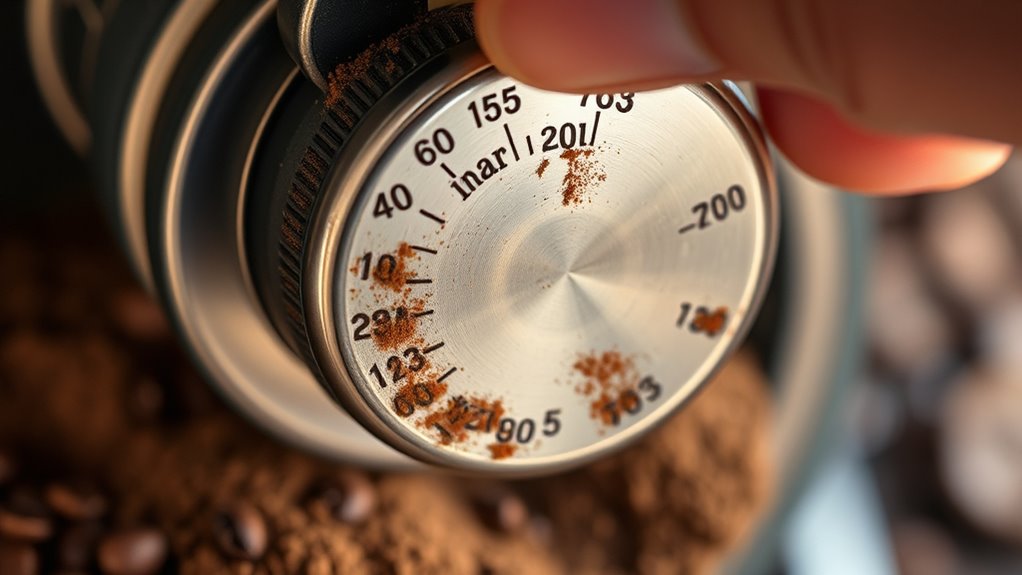
Misinterpreting grind size indicators or labels is a common mistake that can lead to inconsistent coffee quality. Many people rely on grind size labels without understanding that indicator accuracy varies between machines and brands. This can cause you to use the wrong setting, impacting extraction and flavor. To avoid this, keep in mind:
- Grind size labels are approximate, not exact
- Different burr grinders may have different indicator scales
- Always calibrate your grinder to match the desired grind consistency
- Don’t assume a “medium” grind is the same across devices
- Test adjustments by brewing small amounts and observing extraction
- Recognize that bedroom decor elements like lighting and textiles can influence your perception of coffee quality, so creating a comfortable environment may improve your brewing focus and consistency.
Failing to Adjust Grind Size Based on Extraction Results
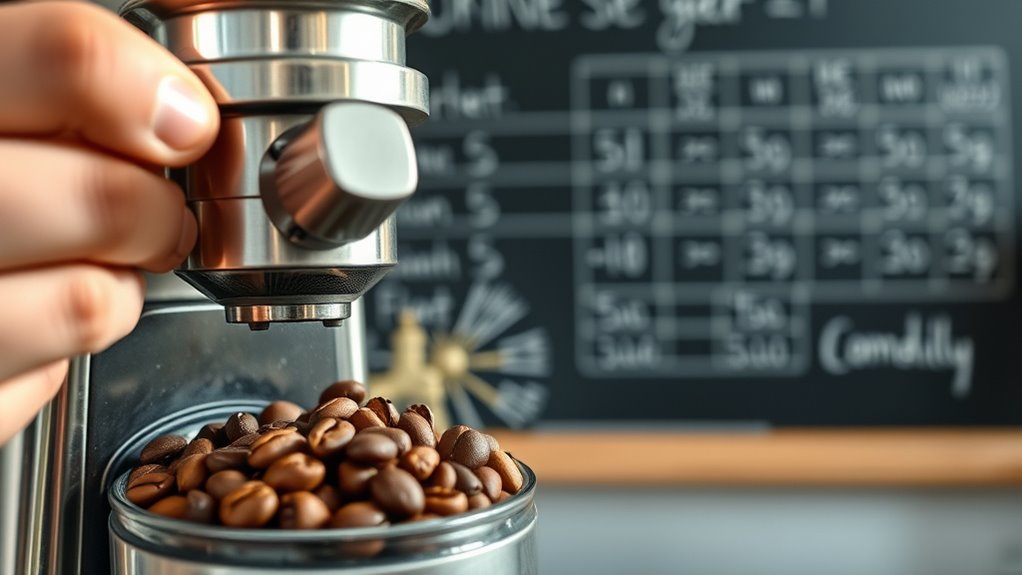
Even if you’ve set your grind size correctly, failing to tweak it based on extraction results can undermine your coffee’s flavor. If your brew tastes bitter or overly harsh, it’s a sign of over extraction, and you should experiment with a coarser grind. Conversely, if it’s weak or sour, your grind might be too coarse, leading to under extraction. Don’t rely solely on preset grind size charts—engage in grind size experimentation to find what works best for your method and beans. Regular over extraction troubleshooting helps you identify whether you need to adjust finer or coarser. Remember, small tweaks can make a big difference. Adjust your grind size based on extraction feedback to consistently improve your coffee’s flavor and avoid brewing mistakes. Utilizing personality insights can also help you understand your preferences and refine your brewing process accordingly.
Frequently Asked Questions
How Does Ambient Humidity Affect Grind Size Consistency?
Ambient humidity affects grind size consistency because humidity effects cause moisture impact on your coffee beans and grinder. When humidity is high, beans absorb moisture, making them harder to grind evenly, which can lead to inconsistent extraction. Conversely, low humidity helps maintain a stable grind size. To counter humidity effects, store your beans in airtight containers and adjust your grinder settings as needed to make certain of uniform grind size regardless of moisture levels.
Can Different Grinder Brands Produce Varying Grind Sizes at the Same Setting?
You’ll find that different grinder brands can produce grind sizes at the same setting as if they’re speaking different languages! It’s wild, but true—each grinder’s calibration varies, affecting grind size uniformity. So, don’t assume a setting works across brands. You gotta dial in your grinder, test it repeatedly, and fine-tune until the grind size matches your ideal. That way, every cup will be consistently perfect, no matter the machine.
Does Altitude Impact the Optimal Grind Size for Brewing?
Altitude effects can considerably influence your brew consistency, so you should adjust your grind size accordingly. At higher elevations, the lower boiling point affects extraction, meaning you might need a slightly coarser grind to prevent over-extraction. Conversely, at lower altitudes, a finer grind can enhance flavor. Pay attention to how your coffee tastes, and experiment with grind size adjustments to maintain ideal brew quality despite altitude changes.
How Do I Know if My Grinder’s Burrs Are Worn Out?
Did you know that burr wear can reduce your grinder’s efficiency by up to 30%? To tell if your burrs are worn out, check for uneven grind size or a noticeable decline in coffee flavor. Regular grinder maintenance includes inspecting burrs for chips or dullness. If you notice these signs, it’s time to replace or sharpen your burrs to maintain consistent grind quality and ideal extraction.
Can Using Filtered Water Change the Ideal Grind Size?
Using filtered water can change the ideal grind size because water mineralization and temperature affect extraction. Mineral-rich water may require a slightly coarser grind to prevent over-extraction, while softer water can handle a finer grind. Additionally, hotter water speeds up extraction, so you might need to adjust your grind size accordingly. Always experiment with small adjustments until you find the perfect balance for your brewing method.
Conclusion
Remember, mastering grind size is like fine-tuning a musical instrument—you need to listen, adjust, and find the perfect pitch. Avoid these common mistakes, and you’ll brew coffee that hits all the right notes. Don’t be afraid to experiment and trust your palate. With a little patience and attention, you’ll turn your grinder into your greatest ally. After all, great coffee starts with a grind that’s just right—tailored to your taste, not just a chart.





